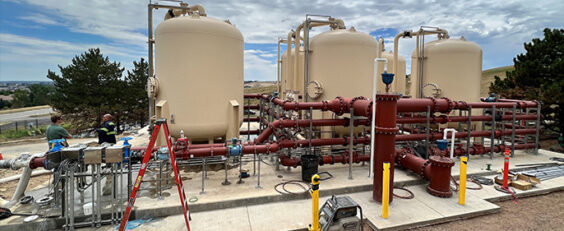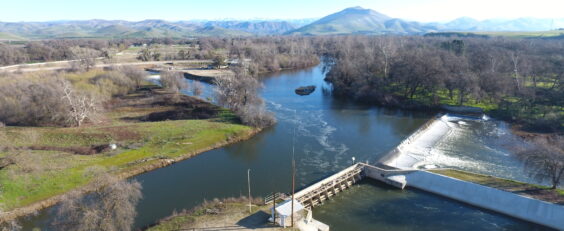Collaborative Effort Helps Alleviate Water Quality Concerns After Colorado’s Most Destructive Wildfire
Sep 2022
Weather patterns in 2021 created ideal wildfire conditions along Colorado’s Front Range. The fall was unusually warm and dry, while winter presented the latest date in Denver history for first snowfall of the season. These circumstances, alongside an unknown spark (or two) and 115-mile-per-hour winds, led to the most destructive wildfire in Colorado history. The fire extended over 6,000 acres and burned more than 1,000 homes to the ground within Boulder County. The impacts of this catastrophe are still felt today. The Town of Superior, Colorado, was at the heart of this event and encountered an unexpected casualty: water quality. Ash and debris from the fires were deposited in and around the Town’s raw water storage facility, which existing treatment equipment was not prepared to handle. This led to the distribution of drinking water that had significant taste and odor issues, causing residents to transition to bottled water.
The Town of Superior, realizing their water quality issues would not be resolved without intervention, quickly brought on Dewberry Engineers to help brainstorm solutions to improve water quality. The design team began testing different treatment methods and determined the insertion of a granular activated carbon (GAC) system onto the backend of the existing treatment train would alleviate water quality concerns. After establishing what the treatment process should look like on paper, the Town acted immediately and purchased six GAC vessels without knowing where they would live, or how they would connect to the existing facility. The next step was determining how to insert these new GAC vessels into an existing and operating facility. Garney was brought onto the team to provide input on constructability, sequencing, and start-up with one goal in mind—to begin using the GAC system as soon as possible.
For this project, time was of the essence in every sense of the phrase. Every day that the GAC system was not online was another day that smoky, discolored water was being delivered to customers. On most construction projects, Garney encounters obstacles that need to be overcome for the project to move forward—things like moving existing utilities, permitting, providing input on design drawings, etc. When you add in the fact that there was a supply chain crisis for virtually all construction materials as well as inflation soaring at unprecedented levels, this project quickly had the odds stacked against it. Garney’s team began reaching out to its vast industry network in search of excess materials that could be used to expedite Superior’s project—things like valves, rebar, pipe, and actuators were all being quoted at six months or longer. This was not an option for the Town.
Through support from industry partners, heavy collaboration with both the Town of Superior and Dewberry, countless design iterations that improved the construction schedule, and an unrelenting spirit, Garney was able to start up the GAC system on July 15, 2022—just three months after receiving the first phone call from the Town and Dewberry. The determination and solution-oriented attitude of the entire team drove this project to completion and ultimately relieved the Town and its customers of its smoky water months before anyone thought was possible. This project is a prime example of a community coming back stronger than ever after a horrific disaster and is why it has been recognized as Project of the Year by the American Public Works Association (APWA) Colorado Chapter.
Written by Jared Baker, PE, Business Development / Preconstruction Manager at Garney
A closer look at water funding in the Infrastructure Investment and Jobs Act
Jan 2022
In November 2021, President Biden signed the Infrastructure Investment and Jobs Act (IIJA). This historic $1.2 trillion bill allocates $55 billion for our country’s water infrastructure. This investment includes funding for drinking water and wastewater treatment projects in hopes to expand access to drinking water to people across the country.
The IIJA includes significant opportunities for our clients and partners in the water market. Comparing the legislation to previous funding levels, it’s easy to see the increases from past financial support. The numbers show a significant increase in funding for water-related projects, including drinking, clean, storm, and delivery. For instance, the authorization of drinking water funds to the State Revolving Fund (SRF) is approximately 2.8 times more than previous appropriations. The funding authorized for clean water is approximately 1.8 times more than previous appropriations, and the U.S. Army Corps of Engineers’ (USACE) civil budget continues to steadily grow and is approximately 55% more than the 2017 appropriation levels. Some traditional federal water programs, such as funding for the Bureau of Reclamation, are not showing significant increases, however, they did not lose ground and still have an authorized increase in funds.
Another change in the IIJA to our legislative water past is the significant focus for funding in underrepresented communities, which include small cities (<10,000 people), towns, and rural regions. We are interested to see how small communities and underrepresented communities will take advantage of these new funding opportunities. Hopefully, the number of regulations attached to the federal funds will not be a deterrent to communities that don’t have the resources to complete the necessary grant and proposal requests. If communities need help with regulatory requirements or proposal writing, Garney and its industry partners can provide assistance or direction as to how our stakeholder communities can navigate the federal aid process. Some of the new federal programs now allow for an outright grant of funds, whereas before, those same funds may have been provided as a loan. In addition, some of the loans are now at significantly reduced interest rates—or in some cases, zero interest. If underrepresented and marginalized communities can develop the proposals, these rule changes will make it easier and more cost-effective for them to build projects.
As for timing—when will we see these funds in tangible projects? Considering the amount of regulations, grants, and proposal writing required for the funds to flow through projects, it is reasonable to assume that the majority of these funds will not have a big impact on our market until 2023.
As a final point, whether the additional federal funding is for water/wastewater work or other areas of heavy infrastructure, the amount of funds available in the next five to ten years for projects in the infrastructure space will significantly increase. This infers that more labor resources will be required in the industry to execute the projects that are an outcome of this additional funding. Finding and developing enough craft workers and project management capable of executing in the construction industry will be a challenge and a requirement for bettering infrastructure in the United States for years to come.
Written by Jay McQuillen, Director of Federal Operations

